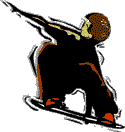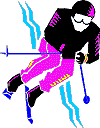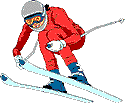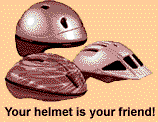 | Helmets for the Slopes? |  |
|
|
|
January 20, 1999
New Recommendations for Helmet Use While Skiing and Snowboarding Have you been skiing or snowboarding this winter? Did you
wear a helmet? On January 8, 1999, the US Consumer Product Safety Commission (CPSC)
released
recommendations for the use of helmets by skiers and snowboarders to
prevent head and brain injuries. Have you been skiing or snowboarding this winter? Did you
wear a helmet? On January 8, 1999, the US Consumer Product Safety Commission (CPSC)
released
recommendations for the use of helmets by skiers and snowboarders to
prevent head and brain injuries. The CPSC estimates that helmets worn by
skiers and snowboarders under 15 years of age could prevent or reduce the
severity of 53% of the head injuries. Helmets worn by adults would prevent
or reduce the severity of 44% of the head injuries.
The CPSC estimates that helmets worn by
skiers and snowboarders under 15 years of age could prevent or reduce the
severity of 53% of the head injuries. Helmets worn by adults would prevent
or reduce the severity of 44% of the head injuries. Head and brain injuries caused by skiing have been in the spotlight since celebrities Sonny Bono and Michael Kennedy both died in ski accidents about one year ago. Although skiing and snowboarding are generally safe sports, improvements in ski equipment and snow grooming methods have allowed people to ski faster. Recreational skiers can reach speeds of 40 miles per hour. Most ski injuries occur when people ski too fast, get out of control, and hit fixed objects like rocks or trees.
|
 For more
information on helmet use during winter sports, see: For more
information on helmet use during winter sports, see:
|
| BACK TO: | Neuroscience In The News | Table of Contents |

![[email]](./gif/menue.gif) Send E-mail |
 Fill out survey |
 Get Newsletter |
 Search Pages |
 Take Notes |
 So
how can skier and snowboarder injuries be prevented and reduced? Here
are some suggestions:
So
how can skier and snowboarder injuries be prevented and reduced? Here
are some suggestions: